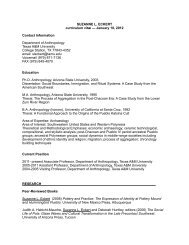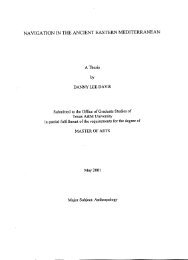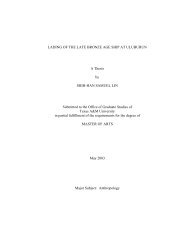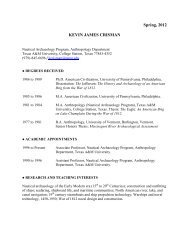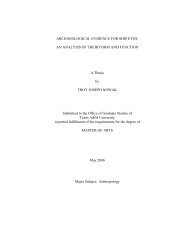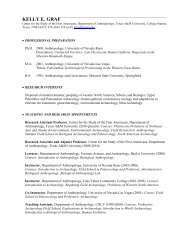faience and glass beads from the late bronze - Department of ...
faience and glass beads from the late bronze - Department of ...
faience and glass beads from the late bronze - Department of ...
You also want an ePaper? Increase the reach of your titles
YUMPU automatically turns print PDFs into web optimized ePapers that Google loves.
11Aegean <strong>and</strong> Cypriot pottery suggests that <strong>the</strong>y were owned by a foreigner, who perhapsexpressed his cultural identity through <strong>the</strong> use <strong>of</strong> distinctive <strong>beads</strong>. 63Amuletic or Religious PropertiesBeads in ancient Egypt possessed a distinct amuletic value, <strong>and</strong> <strong>the</strong>re is anetymological link between <strong>the</strong> Egyptian term for luck <strong>and</strong> that for bead. 64Amulets in<strong>the</strong> form <strong>of</strong> <strong>beads</strong> <strong>and</strong> pendants were widely used in Egypt, as evidenced by <strong>the</strong>thous<strong>and</strong>s <strong>of</strong> clay molds used in <strong>the</strong> production <strong>of</strong> <strong>faience</strong> amulets at Amarna. 65Manyvarieties <strong>of</strong> eye <strong>beads</strong> <strong>and</strong> pendants were also found in Bronze Age Egypt, whichperhaps protected <strong>the</strong> wearer against <strong>the</strong> evil eye. 66This belief in <strong>the</strong> powers <strong>of</strong> <strong>the</strong> evileye, also commonly known as “fascination”, was a widespread phenomenon in <strong>the</strong>ancient world. The primary cause <strong>of</strong> fascination is envy, 67 <strong>and</strong>, in many parts <strong>of</strong> <strong>the</strong>Mediterranean today, <strong>the</strong> simplest charm to protect against this harmful force is a beadrepresenting an eye or merely a blue bead, worn attached to clothing or jewelry. 6863 Petrie 1891, 17, no. 26.64 Dubin 2004, 42.65 Petrie 1974, 28-30.66 Brunton 1928, 25.67 Gifford 1958, 20.68 Maloney 1976, 49. The color blue itself symbolizes protection against <strong>the</strong> evil eye, <strong>and</strong> <strong>the</strong> majority <strong>of</strong>eye <strong>beads</strong> that continue to be produced in <strong>the</strong> eastern Mediterranean are blue. There exist differingexplanations for this preoccupation with <strong>the</strong> color blue. Adorning donkeys with blue or turquoise <strong>beads</strong>might be linked to a belief that <strong>the</strong> stone turquoise enhances <strong>the</strong> sure-footedness <strong>of</strong> <strong>the</strong> animal (Erikson1993, 135). Several anthropologists link <strong>the</strong> commonality <strong>of</strong> blue eye <strong>beads</strong> with <strong>the</strong> rarity <strong>of</strong> that genetictrait in eastern Mediterranean regions (Maloney 1976, 8, 80; Gifford 1958, 21-2). Gifford fur<strong>the</strong>rmoresuggests that any eye abnormality, whe<strong>the</strong>r an uncommon color or a rare defect such as double pupils,suggests an inclination toward fascination. Because studies in magic suggest that “like produces like”,incorporating an abnormality into a talisman will enhance its ability to draw <strong>the</strong> gaze <strong>of</strong> a fascinator; <strong>the</strong>frequent depiction <strong>of</strong> double pupils on eye <strong>beads</strong> <strong>of</strong> various periods certainly supports this <strong>the</strong>ory.Perhaps, though, <strong>the</strong> proliferation <strong>of</strong> blue <strong>beads</strong> simply occurred because <strong>of</strong> <strong>the</strong> ease with which that coloris obtained in both <strong>glass</strong> <strong>and</strong> <strong>faience</strong>. Kçkerman (1988, 81), in studying <strong>the</strong> <strong>glass</strong> bead industry inTurkey, suggests that, because various factors such as temperature, oxidation level <strong>and</strong> rate <strong>of</strong> coolinghave relatively little effect on this blue color, it might have been <strong>the</strong> test color in <strong>the</strong> developmental stages<strong>of</strong> <strong>glass</strong>making. It would follow, <strong>the</strong>n, that blue <strong>beads</strong> were <strong>the</strong> most widely available, <strong>and</strong> <strong>the</strong> preference








